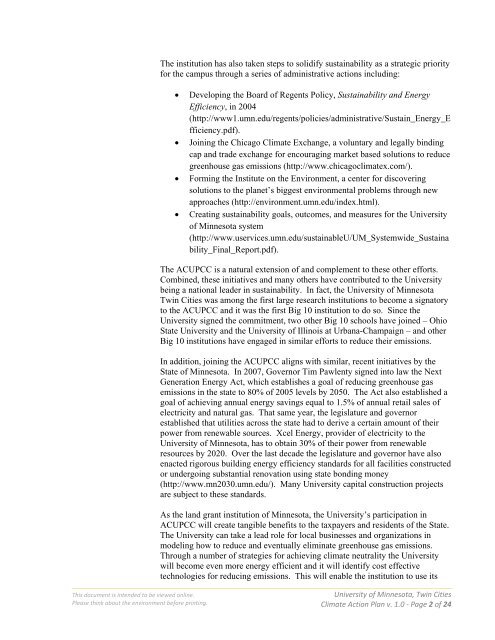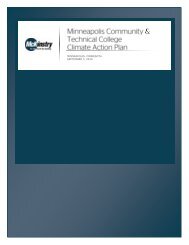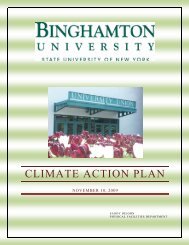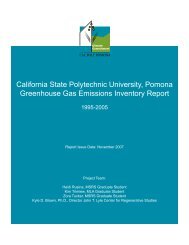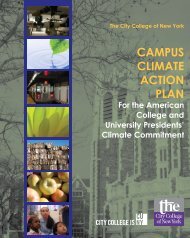The institution has also taken steps to solidify sustainability as a strategic priorityfor the campus through a series of administrative actions including:• Developing the Board of Regents Policy, Sustainability and EnergyEfficiency, in 2004(http://www1.umn.edu/regents/policies/administrative/Sustain_Energy_Efficiency.pdf).• Joining the Chicago <strong>Climate</strong> Exchange, a voluntary and legally bindingcap and trade exchange for encouraging market based solutions to reducegreenhouse gas emissions (http://www.chicagoclimatex.com/).• Forming the Institute on the Environment, a center for discoveringsolutions to the planet’s biggest environmental problems through newapproaches (http://environment.umn.edu/index.html).• Creating sustainability goals, outcomes, and measures for the Universityof Minnesota system(http://www.uservices.umn.edu/sustainableU/UM_Systemwide_Sustainability_Final_Report.pdf).The <strong>ACUPCC</strong> is a natural extension of and complement to these other efforts.Combined, these initiatives and many others have contributed to the Universitybeing a national leader in sustainability. In fact, the University of MinnesotaTwin Cities was among the first large research institutions to become a signatoryto the <strong>ACUPCC</strong> and it was the first Big 10 institution to do so. Since theUniversity signed the commitment, two other Big 10 schools have joined – OhioState University and the University of Illinois at Urbana-Champaign – and otherBig 10 institutions have engaged in similar efforts to reduce their emissions.In addition, joining the <strong>ACUPCC</strong> aligns with similar, recent initiatives by theState of Minnesota. In 2007, Governor Tim Pawlenty signed into law the NextGeneration Energy Act, which establishes a goal of reducing greenhouse gasemissions in the state to 80% of 2005 levels by 2050. The Act also established agoal of achieving annual energy savings equal to 1.5% of annual retail sales ofelectricity and natural gas. That same year, the legislature and governorestablished that utilities across the state had to derive a certain amount of theirpower from renewable sources. Xcel Energy, provider of electricity to theUniversity of Minnesota, has to obtain 30% of their power from renewableresources by 2020. Over the last decade the legislature and governor have alsoenacted rigorous building energy efficiency standards for all facilities constructedor undergoing substantial renovation using state bonding money(http://www.mn2030.umn.edu/). Many University capital construction projectsare subject to these standards.As the land grant institution of Minnesota, the University’s participation in<strong>ACUPCC</strong> will create tangible benefits to the taxpayers and residents of the State.The University can take a lead role for local businesses and organizations inmodeling how to reduce and eventually eliminate greenhouse gas emissions.Through a number of strategies for achieving climate neutrality the Universitywill become even more energy efficient and it will identify cost effectivetechnologies for reducing emissions. This will enable the institution to use itsThis document is intended to be viewed online.Please think about the environment before printing.University of Minnesota, Twin Cities<strong>Climate</strong> <strong>Action</strong> <strong>Plan</strong> v. 1.0 ‐ Page 2 of 24
state provided resources more efficiently. Furthermore, as the land-grantinstitution of Minnesota, the University is uniquely positioned to develop,demonstrate, and share these solutions with individuals and organizations aroundthe state. Finally, as one of the larger purchasers of goods and services inMinnesota, the University has the opportunity to facilitate the growth of localjobs associated with a green economy, and it can further state and regional effortsto create energy independence.<strong>Climate</strong> <strong>Action</strong> <strong>Plan</strong> Development ProcessThe CAP is the product of a number of related initiatives over several yearswhose cumulative effect is to advance sustainability broadly at the institution.These efforts, which are the foundation of the CAP, include:• Energy Management Principles. In the early 2000’s, the Universitydepartment of Energy Management established a set of guidingprinciples. These principles – Reliability, Environmental Stewardship,and Cost Control – are the paradigm for decisions on how to provideelectricity, heat, and cooling to the campus, and they helped shapedevelopment of the Regents Policy: Sustainability and Energy Efficiency.• University of Minnesota Board of Regents Policy: Sustainability andEnergy Efficiency. The policy defines sustainability as a “continuouseffort integrating environmental, social, and economic goals throughdesign, planning, and operational organization to meet current needswithout compromising the ability of future generations to meet their ownneeds.” It commits the University of Minnesota to incorporatesustainability into teaching, research, outreach, and operations under thedirection of six guiding principles: leadership, modeling, operationalimprovements, energy efficiency, research, and education and outreach.The comprehensive nature of the policy supports decisions that willcreate healthier communities for the people of Minnesota.• Creation of the University Services Sustainability Steering Committee.University Services, which is responsible for a number of operationalfunctions addressed by the Sustainability and Energy Efficiency policy,formed a steering committee to begin addressing and advancing thepolicy goals.• Professional sustainability staffing. In 2008, the Twin Cities campushired full-time professional staff focused on advancing sustainabilityefforts within operations and the curriculum, and additional staff havebeen added since.• Systemwide Sustainability: Goals, Outcomes, Measures, Process. InApril 2008 University of Minnesota President Robert H. Bruininksestablished a 23-member systemwide committee composed of faculty,staff, and students. The committee proposed goals and performanceThis document is intended to be viewed online.Please think about the environment before printing.University of Minnesota, Twin Cities<strong>Climate</strong> <strong>Action</strong> <strong>Plan</strong> v. 1.0 ‐ Page 3 of 24
- Page 1: Climate Action Planfor the Universi
- Page 5: IntroductionThe American College an
- Page 9 and 10: The criteria being used for the eva
- Page 11 and 12: Table 1 - Emissions Sources by Scop
- Page 13 and 14: personal steps to conserve energy,
- Page 15 and 16: ecommissioning all buildings on a f
- Page 17 and 18: Curriculum• Over the past two yea
- Page 19 and 20: • Local, state, and federal polic
- Page 21 and 22: Appendices• Appendix A - Meetings
- Page 23: Appendix B - Initial list of strate
- Page 27 and 28: University of MinnesotaTwin CitiesG
- Page 29 and 30: Table of ContentsTable of ContentsE
- Page 31 and 32: IntroductionIntroductionOn January
- Page 33 and 34: EmissionsEmissions by ScopeScopes h
- Page 35 and 36: Total EmissionsTotal EmissionsThe t
- Page 37 and 38: TransportationEmissions from Direct
- Page 39 and 40: Purchased ElectricityEmissions from
- Page 41 and 42: CommutingEmissions from CommutingTh
- Page 43 and 44: WasteEmissions from WasteIncinerati
- Page 45 and 46: Appendix 1Snapshot of Clean Air Coo
- Page 47: Appendix D - Decision Criteria for
- Page 51 and 52: University of MinnesotaSystemwide S
- Page 55 and 56: University of MinnesotaBoard of Reg
- Page 57 and 58:
University of MinnesotaSustainabili
- Page 59 and 60:
PrefaceThe test of the University
- Page 61 and 62:
Executive SummaryIn July 2004, the
- Page 63 and 64:
High-Level GoalsThe following high-
- Page 65 and 66:
GoalsLeadership and ModelingGoal 1:
- Page 67 and 68:
in teaching, research, outreach, an
- Page 69 and 70:
Numerous efforts on individual camp
- Page 71 and 72:
leadership, the strategic planning
- Page 73 and 74:
Goals, Desired Outcomes, MeasuresWh
- Page 75 and 76:
Leadership and ModelingBoard of Reg
- Page 77 and 78:
Leadership and Modeling Goal 2Activ
- Page 79 and 80:
Leadership and Modeling Goal 4Make
- Page 81 and 82:
Operational ImprovementsBoard of Re
- Page 83 and 84:
Strategic building planning and des
- Page 85 and 86:
Energy EfficiencyBoard of Regents P
- Page 87 and 88:
Energy Effi ciency Goal 1Reduce ene
- Page 89 and 90:
To meet ACUPCC goals, each campus h
- Page 91 and 92:
“Our commitment toexcellence is a
- Page 93 and 94:
The University of Minnesota should
- Page 95 and 96:
Education and OutreachBoard of Rege
- Page 97 and 98:
. The sustainability focus of servi
- Page 99 and 100:
Bringing knowledge to the wider com
- Page 101 and 102:
importance of integrating sustainab
- Page 103 and 104:
Implementation and ReportingIn the
- Page 105 and 106:
StructureSustainability committees
- Page 107 and 108:
AcknowledgmentsLeadership and Model
- Page 109 and 110:
Campus ConsultationsThe committee w
- Page 111 and 112:
Sustainability and Uhttp://www.user
- Page 113 and 114:
AdministrativeSUSTAINABILITY AND EN
- Page 115 and 116:
Appendix F - Related Reports and We


